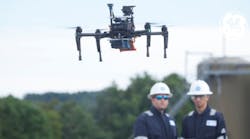General Electric Co. (IW 500/6) has a solution for U.S. oil and natural gas explorers struggling to save more money after squeezing drilling costs by more than a third during the past two years.
Raven, a helicopter drone being developed in part by GE at its new $125 million oil and gas technology center in Oklahoma City, is being tested to sniff for methane emissions at well sites. GE proved during a trial run in July that Raven could find gas leaking from a pair of well sites a half mile from each other in the Fayetteville Shale of Arkansas.
Detecting and stopping leaks, a requirement the Environmental Protection Agency enacted earlier this year, is the first of many planned applications for oilfield drones to make workers more productive in an industry that has suffered billions of dollars in spending cuts, hundreds of thousands of layoffs and more than 100 bankruptcies in North America over the past two years. A broader benefit will come from Raven’s custom software, used to plan flight paths and easily interpret the mountains of data it gathers.
"When you think of Project Raven and the usage of new tools and applications, it’s going to be key to take the industry forward," Lorenzo Simoneli, chief executive officer at GE Oil & Gas, said in an interview from his company’s new research center, a day ahead of its grand opening. "There’s a lot that you can do going forward to help drive productivity."
Data Dump
The world’s largest oilfield contractors are grappling with new ways to set themselves apart with inventions that not only capture massive amounts of data but also make it user-friendly for oil companies. GE’s foray into drones comes at a time when regulators are still mapping out rules for their commercial use.
"The downturn magnified the necessity of maximizing recovery and efficiency, a pursuit which is blurring the lines between technology, industrials, and oilfield service leaders," James West, an analyst at Evercore-ISI, wrote last month in a note to investors.
As more advanced sensors roll out, the amount of oilfield data grows faster than companies know what to do with it. Key oil and gas decision makers have access to only about 1% of the available data, West wrote. The rest is unstructured or unusable.
Integrating Data
GE’s oilfield drone project began last year after some of its other industrial divisions explored how they could use unmanned aircraft. Other applications could include inspecting flare stacks at refineries or checking gear for mechanical wear and corrosion, John Westerheide, head of the Raven project, said in an interview.
"Where GE’s taking this from something a guy in a garage can do to what only GE can do, it’s around the way we’re communicating and planning the flights and the way we’re integrating the data," Westerheide said.
The test in July was done in partnership with Southwestern Energy Co. and Oklahoma State University. The drone technology looked promising enough that Southwestern’s interested in testing the Raven again, said Douglas Jordan, director of the natural gas and oil producer’s corporate environmental program, said. It’s still too early to say what kind of cost savings the drone could produce, he said.
Faster Inspections
GE is working on having Raven make methane inspections go three times faster, said Ashraf El-Messidi, a research engineer for GE working on the project. Under the current way, a worker must walk around the well with an infrared camera to check for leaks. And even if one is discovered, it works like a smoke detector, giving only a yes or no answer, but not saying how significant the leak might be, he said.
In another month, GE will launch a third test drone, this one a black-and-red model with six sets of helicopter blades, each 21 inches long. Weighing in at less then 20 pounds, the drone can glide through the air at up to 50 miles an hour, powered by six rechargeable batteries. The true value in GE’s modified drone is being able to fly as long as 40 minutes, carrying a laser-based sensor that shoots back live methane data to an iPad-wielding worker on the ground.
Dustin Sharber, a 30-year-old drone hobbyist who’s also a research engineer on the Raven team, said advancement of the flying robots has climbed "leaps and bounds" from the radio-controlled planes of his childhood.
"People hear UAVs and drones and advanced sensors and they get really excited -- that’s really flashy," Westerheide said. "That is legitimately really cool, fun stuff to come to work for everyday."
By David Wethe




